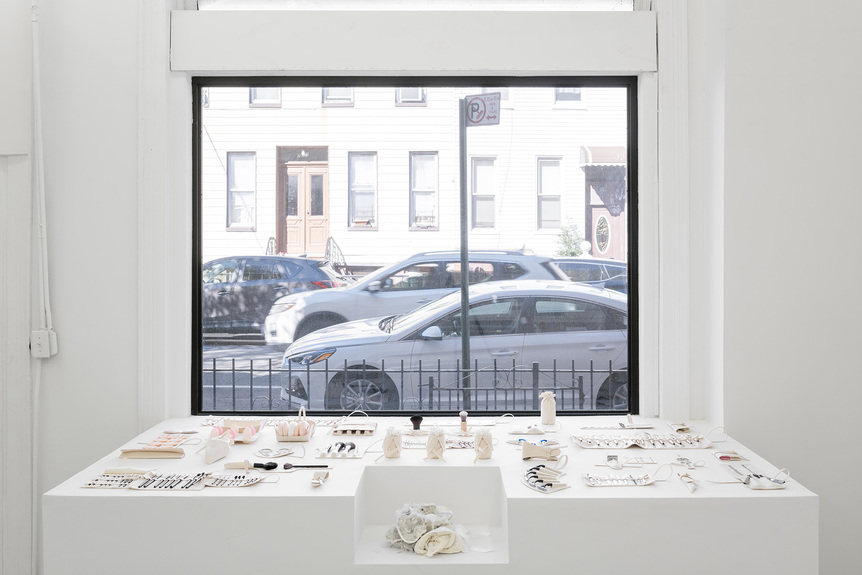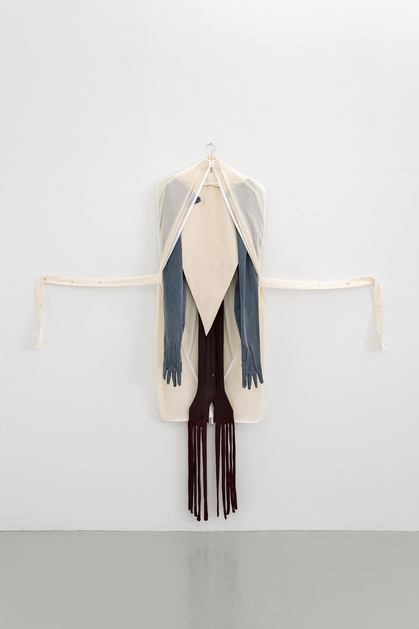-
From Current Issue
-
- Editor’s Letter Fire in the Heart
- Reviews I Gusti Ayu Kadek Murniasih
- Reviews 11th Seoul Mediacity Biennale: “One Escape at a Time”
- Dispatch Networked China
- One on One Monira Al Qadiri on Yukio Mishima
- Essays The rise of independent art spaces in pandemic-era Shanghai
- Features Tuan Andrew Nguyen
- Table of Contents
- Web Exclusives
- Archive
- Subscribe

R
E
V N
E
X
T
Installation view of BRUNO ZHU’s “Guts” at Kimberly-Klark, New York, 2019. All images courtesy the artist and Kimberly-Klark, New York.
A brew of fashion, commerce, and utility comes into play in Bruno Zhu’s art. The 27-year-old first made a splash with precise, compositionally balanced photographs that turned the mundane world around him slightly abstract. In recent years, however, drawing on his training in fashion design, he has created installations that explore corporeal relationships with fabric and clothing. Staged at Kimberly-Klark, a modest, one-room exhibition space
in Queens, Zhu’s solo exhibition, “Guts,” was his most explicit project tackling this relationship to date.
Despite its title and preoccupation with the body, the show was not some David Cronenberg-ian exercise in body horror, but a study of fabric and muscle fiber presented in a clean and minimalistic manner. The first installation one encounters upon walking through the space is Joy, b. (2019), which consists of a neat display of cosmetic tools placed in canvas holsters, cases, and containers. There are oblong, pocket-sized mirrors; razors of various sizes and shapes, one type of which adds a splash of blue in an otherwise beige, black, pink, and chrome palette; brushes for shaving and makeup; tiny scissors; and three cups full of Q-tips. All of the items were carefully placed and set on a raised platform, with an inset shelf for the centerpiece: a mesh fabric nest, sprinkled with white feathers and adorned with a white ribbon, inside of which a bar of soap lies snuggled like an egg. There is fetishistic pleasure in the layout of these items. At the same time, the symmetry of the spatial organization gives the installation a slightly clinical feel. As noted by the gallery’s co-director Dennis Witkin, the titles of the exhibits hint at their meaning, with the “b” in Joy, b. indicating birth, for instance. The piece’s fastidious arrangement suggests that not only are these tools the source of this particular emotional state, but that joy can also materialize, be external and autonomous. Notably, the installation names on the image checklist sent to the press were not italicized, a “conceptual decision on Bruno’s part to break the work free of a subjected art-objectness,” according to Witkin. These objects, lovingly arrayed, are life forms of their own.
On one wall hung a sole installation, another “being” titled Man in the closet (2017–19). This was a droll figural piece made out of denim, wool, cheesecloth, and canvas. The light-blue denim, taken from men’s trousers, makes up the chunky fingers and arms, while burgundy wool forms the feet and droopy, elongated toes. The creamy beige canvas and cheesecloth garment bag (the clasps of which are pinned outward and away on the wall) performs a dual role, resembling a torso but also serving as a container in which the patchwork figure could be stored. Moreover, as the title implies, these fabrics act as a metaphorical closet, covering and hiding sexual identity. As such, they are visual markers of constriction.
Before leaving the gallery, one encounters Zhu’s final piece, I’m fine, alone (2018–19), a box suspended from the ceiling with strips of canvas. Within the box rests a gray head, with black hair spewing out over the eye sockets, and a single eyeball faintly, unblinkingly peering out where the nose should be. The restriction found in Man in the closet is taken further in this piece, with the fully enclosed head redolent of isolation. There’s a sense of comfort in its seclusion, as indicated by the titular phrase “I’m fine.” At the same time, the separation of “I’m fine” and “alone” with a comma also discloses perhaps a denial or downplaying of loneliness.
“Guts” was an elusive show, made more so by the absence of an artist statement or background context in the press release, which included only a dialogue emphasizing the performative element of social roles. Zhu presented his works as they were, with no material to influence viewers’ thinking. Taken together, however, the three pieces in “Guts” generated thoughts on the relationship between interior and exterior, displaying and covering. In Bruno Zhu’s work, clothes don’t make the man, clothes are the man.
Bruno Zhu’s “Guts” is on view at Kimberly-Klark, New York, until May 26, 2019.
To read more of ArtAsiaPacific’s articles, visit our Digital Library.


















